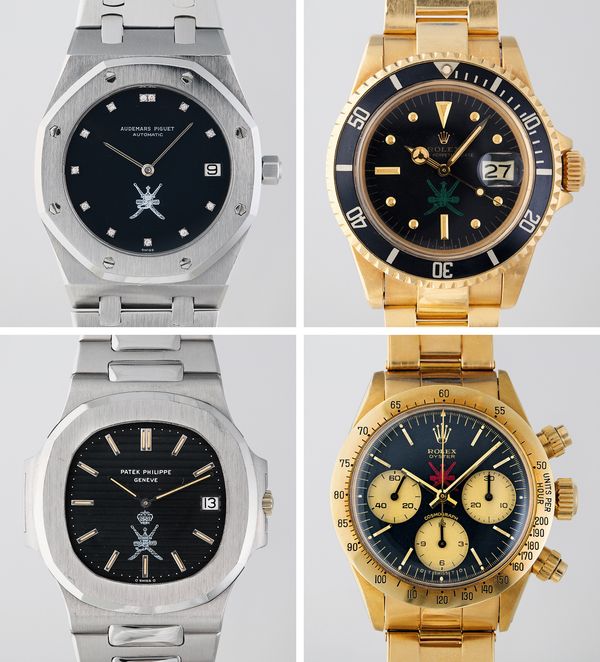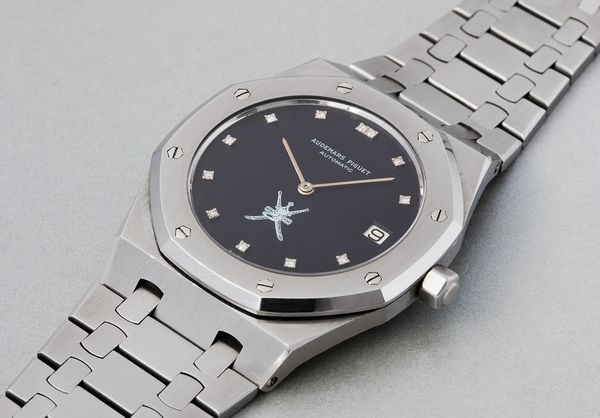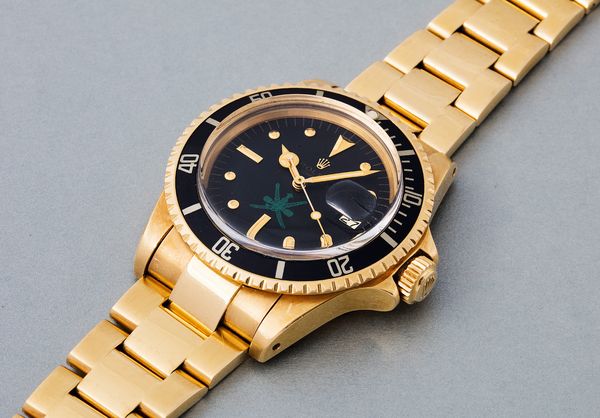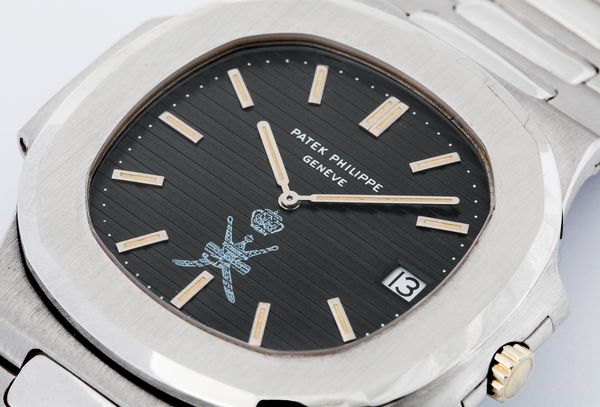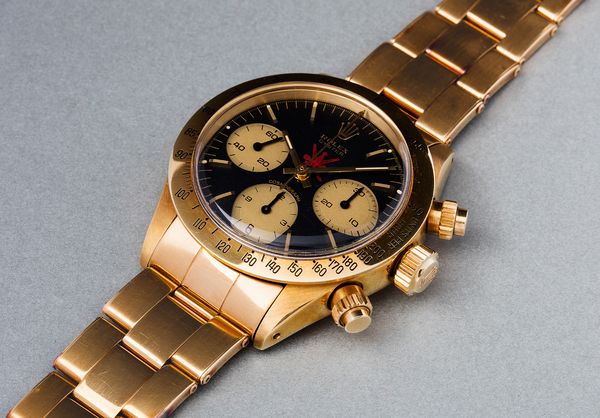(Clockwise from top left) Audemars Piguet Royal Oak A-Series "Oman", 5402 ST, Stainless steel, 1973; Rolex Submariner, 1680, 18k yellow gold, 1974; Patek Philippe "Jumbo" Nautilus "Oman", 3700/1, 18k white gold, 1978; Rolex Oyster Cosmograph "Oman", 6265, 18k yellow gold, 1973.
With its enviable, strategically important location at the mouth of the Persian Gulf, the Sultunate of Oman enjoys one of the most dynamic and fascinating histories of all Middle Eastern nations. Beginning in the late 17th century, its influence spread across the Middle East while it forged a powerful empire. Ultimately, its control expanded beyond the Straight of Hormuz, reaching what are known today as Iran and Pakistan. Today, following a period of influence from the United Kingdom during the last century, the Sultanate ranks amongst the world’s most peaceful, and highest-earning nations.
Emblazoned on Oman’s white, red, and green flag is its national emblem, the Khanjar—a traditional dagger originating from the country used for ceremonial occasions. When found on a wristwatch they are rendered extremely rare, and are considered amongst the world’s most sought after collectible watches. So-called "Khanjar" watches were direct commissions from the Sultan of Oman, His Majesty Sultan Qaboos bin Said al Said, who is well known for his enthusiasm for horology and his own formidable collection. His Majesty was born on November 18th of 1940, the only son to then Sultan Said bin Tamur and Princess Mazoon al-Mashani. He studied in India under the former President of India, Dayal Sharma, and at the age of 20, began his military training joining the Royal Military Academy in Sandhurst in Camberley, Surrey, England.
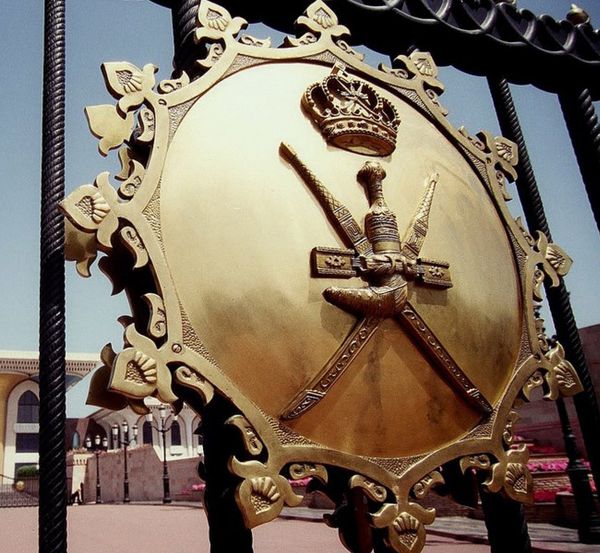
His Majesty Sultan Qaboos bin Said al Said ascended to the throne on July 23rd of 1970. His reign has been one of great success: modernizing his country, strengthening international relations and advances in healthcare, education and infrastructure. Consequently, the nation was recently ranked as the world’s most improved nation in terms of development over the past 40 years.
The timepieces he commissioned were personalized, either with the image of the Khanjar superimposed upon two crossed swords sometimes surmounted by a crown, or with His Majesty’s signature, and given as gifts to loyal servants and foreign dignitaries. With three prestigious brands represented, we offer four rarely seen examples of "Khanjar" wristwatches. Distinguished with white, red, or green Khanjar emblems on their dials, the colors coincidentally span all the colors of the Omani flag. Along with their incredible condition, their Royal provenance renders them amongst the finest collectors wristwatches one can find in today’s market.
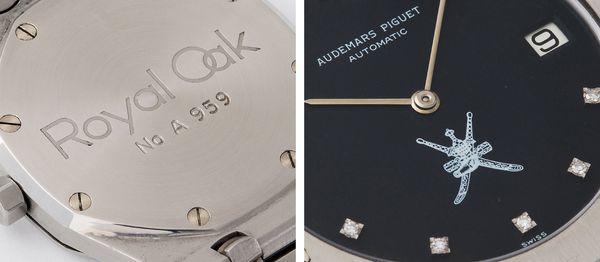
Details of the Audemars Piguet Royal Oak A-Series
Thanks to its Royal provenance, this Audemars Piguet Ref. 5402 ST Royal Oak A-Series "White Khanjar" is one of the rarest and most exciting examples of an early Royal Oak "Jumbo" to appear at auction in recent memory. Part of the earliest and most desirable "A-Series" production, this reference 5402 was the 959th Royal Oak made. Taking its exclusivity and desirability to an even higher level is the presence of the 'Khanjar" daggers on the dial at 6 o’clock – the national emblem of Oman.
Finding any A-Series Royal Oak is not easy, and finding one as well preserved as this is far more difficult.
Audemars Piguet Royal Oak A-Series "Oman", 5402 ST, Stainless steel, 1973
This A-Series example represents a rare opportunity to own one of the world’s most important Royal Oak watches. The dial is exceptional, without the characteristic "mini-tapisserie" guilloché surface found on all other A-series Royal Oaks. This fat black surface was better suited to apply the Khanjar emblem, demonstrating that this dial was custom designed for His Majesty. Furthermore, 12 round brilliant-cut diamond hour markers serve to enhance its beauty. Finding any A-Series Royal Oak is not easy, and finding one as well preserved as the this is far more difficult.
Rolex Submariner, 1680, 18k yellow gold, 1974
Officially launched in 1966, the reference 1680 was the first of the Rolex Submariner family to include the date. Interestingly, reference 1680 was also Rolex’s first Submariner to be offered in gold. On the gorgeous black dial of this Submariner at 6 o’clock, emblazoned in elegant green, are found the highly coveted "Khanjar" daggers signifying its royal provenance. The fact that this example is in gold signifes that it was most certainly offered as a gift to a high ranking dignitary.
The "Khanjar" emblem on the dial also provides for particular purity as all the printing habitually found on the Submariner dial here are nonexistent. Watches with this emblem are extremely sought after, and due to their exceptional rarity, few appear on the market.
Patek Philippe "Jumbo" Nautilus "Oman", 3700/1, 18k white gold, 1978
This Patek Philippe Ref. 3700/1 "White Crowned Khanjar" takes a very prestigious position as being amongst the rarest, most exclusive, and certainly the most coveted examples of a Nautilus ever offered at auction. Amongst its many virtues, its bold, white Khanjar at 6 o’clock makes it an extraordinary watch of Royal provenance—and amongst the rarest of all Khanjar watches known to exist. In fact, until now, the present "Jumbo" Nautilus in white gold is the only publicly known example in white gold featuring the crowned Khanjar.
Amongst its many virtues, its bold, white Khanjar at 6 o’clock makes it an extraordinary watch of Royal provenance—and amongst the rarest of all Khanjar watches known to exist.
At a similar level of importance, it further stands out with a solid 18-karat white gold case and bracelet—an exceptionally rare and ultra-luxurious configuration for such an early Nautilus. Manufactured in 1978, it is one of less than 10 white gold examples to have appeared at auction since the model’s original launch in 1976.
Made on special commission for His Majesty, this "Khanjar" watch was without a doubt given by him as a gift to a close, high-ranking associate or foreign dignitary. According to scholarship, the tradition of gifting watches by His Majesty began following his defeat of the Dhofar Rebellion working in partnership with the British government. As an expression of his gratitude to the teams of Britain’s elite Special Forces branch, the SAS, he presented "Khanjar" watches to the SAS soldiers who were instrumental in defeating the rebellion. Shortly afer the victory, His Majesty commemorated the occasion by surmounting the Khanjar with a crown. All watches made for him since then feature this attractive, crowned Khanjar.
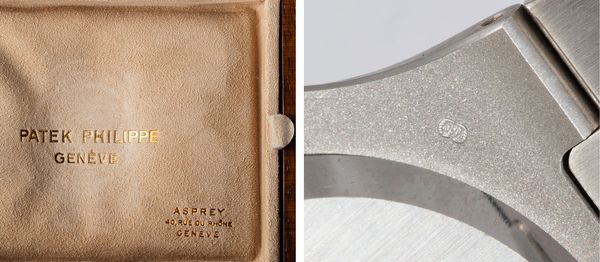
Details of the Patek Philippe "Jumbo" Nautilus
As there were no authorized retailers in Oman at the time, nearly all of these watches were ordered and sold through Asprey London. On rare occasion, very few were sold through Asprey Geneva, as was this example. Accordingly, the watch is accompanied by its original box, stamped with the identical crowned Khanjar as found on the watch’s dial. On the box’s inside cover, the prestigious stamp 'Asprey, 40 Rue
du Rhone, Geneva' is found.
This particular example is preserved in exceptional condition. With hardly any signs of wear and never having been polished, the sharp bevels, angles and curves are perfectly preserved. The dial is original and absent of any restorations, with beautifully aged luminous baton hour markers that match perfectly the original hands. The Extract from the Archives confrms the case and bracelet as white gold, as well as the dial, with its steel baton hour markers. Its historical signifcance, royal provenance, immaculate condition, and, superb rarity make it one of the most exciting and important Patek Philippe Nautilus watches to appear at auction in recent years.
Rolex Oyster Cosmograph "Oman", 6265, 18k yellow gold, 1973
Boldly emblazoned in the upper center of the dial of this stunning 18 karat gold Rolex Cosmograph Daytona is the red "Khanjar". The "Rolex Oyster" logo at 12 o’clock was repositioned higher on the dial to accommodate the Khanjar, demonstrating that this dial was custom designed for His Majesty. The matte black dial further enhances the beauty of the red Khanjar, while the beautifully aged champagne sub-dials give the watch a sporty and elegant aesthetic. At the dial’s bottom edge at six o’clock the desirable sigma designations flanking "T SWISS T" are found, signifying the use of gold for the hour markers and hands.
Details of the Rolex Oyster Cosmograph
The caseback of this extraordinary timepiece features the crisply engraved Asprey, which at the time was Rolex’s Middle East distributor of personalized watches destined to Oman. The case and caseback display all their crisp edges and factory finished surfaces, with thick, well-defined lugs. Fitted with its original and correct Mark II pushers, with pleasing oxidation visible on some of the bracelet’s links, in our view, the watch was rarely worn and was likely never polished.
Finally, the inner caseback is engraved with the same serial number stamped between the lugs at 6 o’clock, indicating that this watch was indeed made by Rolex upon a special order. Its royal provenance, spectacular condition, and superb rarity make it one of the most exciting and important Rolex sport watches to appear at auction in recent years.
